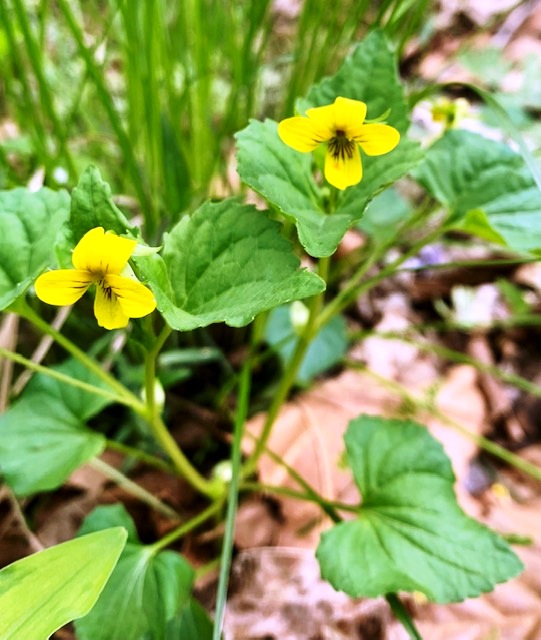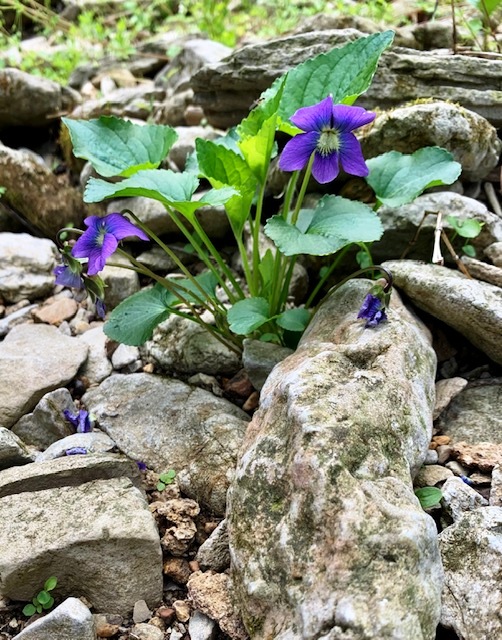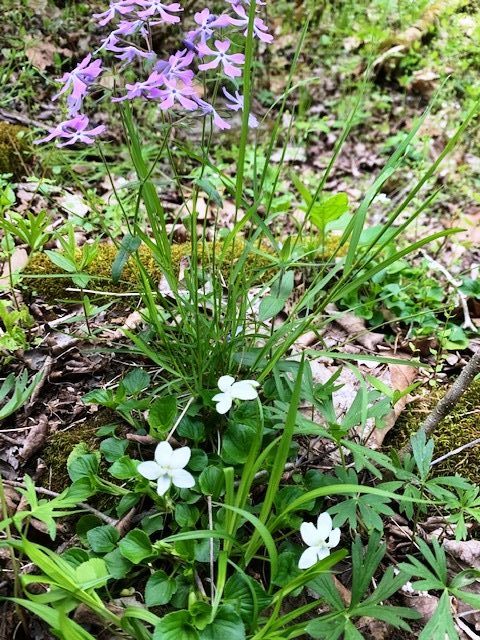The meaning of the violet changes depending on the color of the flower and the person the flower is sent to. Blue violet flowers symbolizes love and faithfulness, white violets represent purity and chastity, and yellow violets symbolize high worth and goodness.
On Sunday’s post, I invited you all along on a wildflower hunt and then asked you about your favorite wildflowers. I was a little surprised that several of you claimed the common violet as a favorite. I’m right there with you all. I think they are beautiful and I enjoy seeing them turn our yard purple in the spring even though I know not every person likes seeing violets among the grass in their lawns.
So, for those of you who are violet fans, I went out on the internet to see what I could find out about the common purple violet and the yellow and white ones I found when I went wildflower hunting down by the creek. That’s where those yellow and white varieties love to grow and bloom.
The violet up top is the common blue violet and yes, sometimes they are more purple than blue. This is the one that will grow almost anywhere including in a rocky creek bed.
Common violet flower meanings include innocence, everlasting love, modesty, spiritual wisdom, faithfulness, mysticism, and remembrance. There are several legends about the violets. One with a Christian background is that violets symbolize the Virgin Mary’s humility and the flowers blossomed when the angel Gabriel told Mary that she would have a baby even though she was a virgin.
The Downy-Yellow Violet is a native wildflower that likes to grow in rich soil in wooded areas. It likes part sun to part shade in loose soils with organic matter.
Pale Violet is a native wildflower found in moist to wet areas of low woods, right where I went wildflower hunting on Sunday. It self-seeds and prefers light shade to partial sun and rich loamy soil. It blooms from May to June and the blooms are long-lasting.
The leaves and flowers of the common blue violet, along with many other species, are edible and medicinal. Violets contain high amounts of vitamin C and vitamin A. The edible violet plant can be used to make syrups, brew teas, and in baked desserts. Flowers can be added to salads and soups as garnish.
Some Interesting Trivia about Violets
~The violet is the state flower of Rhode Island, Illinois, New Jersey, and Wisconsin.
~The violet was Emperor Napoleon Bonaparte’s signature flower. He used the flower to cover his wife’s grave when Josephine died in 1814. In addition, some of Bonaparte’s supporters were known to use violet flowers to assess if subjects were loyal to the emperor by asking them if they liked the flowers.
~In Victorian times, violet flowers were often symbolic of good humility and fortune. Some even believed that carrying violets might keep evil spirits at bay, while another traditional belief was that wearing violets on top of one’s head would alleviate inebriation.
~Violets contain a chemical substance that may interfere with a person’s scent receptors. After a period of time, the nose may become affected by the chemical substance, and the person can no longer detect the scent of a violet. While some violets do have a sweet scent, others don’t. The common blue violet is one that doesn’t.
~There are thought to be around 500 species of violets today that belong to the genus Viola. Several of the species are also known as pansies. While I didn’t know that, I did know pansies were edible since I once ate them in a salad at a bed and breakfast.
~Ancient Greeks used violets in wine, food, and medicine. The plant was seen as the symbol of fertility and love, and as such was used in love potions. It was also thought to ward off headaches and dizzy spells.
~Violets also are the official birth flower for February.
Giveaway
I hope you enjoyed finding out more about the violet the same as I did. You still have time to enter my giveaway for a choice of one of my autographed books for yourself or for a friend, if you’re the winner. Deadline to enter is midnight EST Saturday, April 24, 2021. All you have to do to enter is leave a comment, and if you commented Sunday and you comment again on this post, you’ll get a second entry.
So, which facts about violets did you find surprising or interesting? Have you ever tried violets in a salad?




Comments 45
Well, that was a fun and interesting read. I love Violets!
Author
Glad you enjoyed reading all about violets, Mary Ann. Since it had been a while since I wrote this post, I reread it and the same as you found all those things I found out about violets interesting and fun again too. 🙂